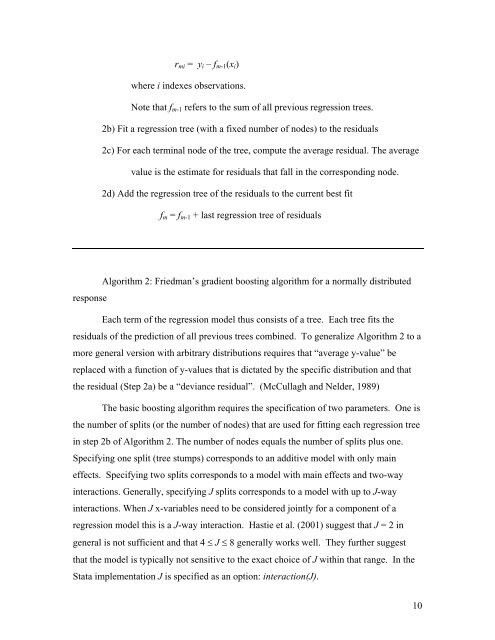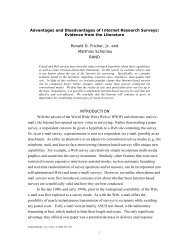Boosted Regression (Boosting): An introductory tutorial and a Stata ...
Boosted Regression (Boosting): An introductory tutorial and a Stata ...
Boosted Regression (Boosting): An introductory tutorial and a Stata ...
You also want an ePaper? Increase the reach of your titles
YUMPU automatically turns print PDFs into web optimized ePapers that Google loves.
mi = y i – f m-1 (x i )where i indexes observations.Note that f m-1 refers to the sum of all previous regression trees.2b) Fit a regression tree (with a fixed number of nodes) to the residuals2c) For each terminal node of the tree, compute the average residual. The averagevalue is the estimate for residuals that fall in the corresponding node.2d) Add the regression tree of the residuals to the current best fitf m = f m-1 + last regression tree of residualsAlgorithm 2: Friedman’s gradient boosting algorithm for a normally distributedresponseEach term of the regression model thus consists of a tree. Each tree fits theresiduals of the prediction of all previous trees combined. To generalize Algorithm 2 to amore general version with arbitrary distributions requires that “average y-value” bereplaced with a function of y-values that is dictated by the specific distribution <strong>and</strong> thatthe residual (Step 2a) be a “deviance residual”. (McCullagh <strong>and</strong> Nelder, 1989)The basic boosting algorithm requires the specification of two parameters. One isthe number of splits (or the number of nodes) that are used for fitting each regression treein step 2b of Algorithm 2. The number of nodes equals the number of splits plus one.Specifying one split (tree stumps) corresponds to an additive model with only maineffects. Specifying two splits corresponds to a model with main effects <strong>and</strong> two-wayinteractions. Generally, specifying J splits corresponds to a model with up to J-wayinteractions. When J x-variables need to be considered jointly for a component of aregression model this is a J-way interaction. Hastie et al. (2001) suggest that J = 2 ingeneral is not sufficient <strong>and</strong> that 4 ≤ J ≤ 8 generally works well. They further suggestthat the model is typically not sensitive to the exact choice of J within that range. In the<strong>Stata</strong> implementation J is specified as an option: interaction(J).10



